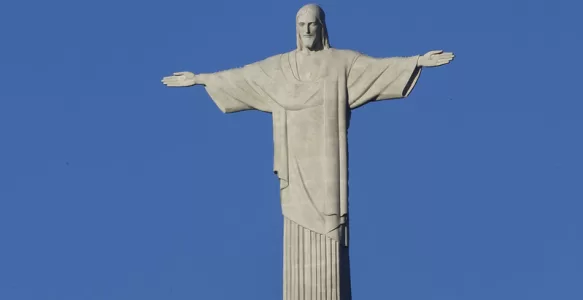Corcovado, one of Brazil’s most iconic landscapes, is much more than a simple rocky formation within Tijuca National Park. Standing at 710 meters above sea level, it embodies a convergence of history, culture, nature, and faith, serving as a national symbol that attracts millions of visitors annually. Its origins date back millions of years, its ecological significance is vital for the preservation of the Atlantic Forest, and its presence in Brazilian culture is invaluable. This article aims to explore the richness of Corcovado, including its geological origins, environmental importance, cultural and tourism roles, as well as current conservation challenges.

Geological Origins and Natural Formations
Corcovado is an igneous formation resulting from geological processes that occurred approximately 300 million years ago. Its origin is linked to an ancient volcano, whose activity led to the formation of highly resistant microgranular rocks. These rocks have withstood the test of time, climate, and human activity, forming one of Brazil’s most recognizable landscapes.
Its geological formation is a testament to the natural history of the region. Over millions of years, erosion and other natural processes shaped the terrain, leaving Corcovado as one of the main elevations within Tijuca National Park. Its resilience to weathering is one of the reasons why its silhouette remains imposing and intact, even after centuries of climate and human influence.
History and Cultural Significance
Corcovado’s history is deeply intertwined with that of Rio de Janeiro and Brazil. Since the 19th century, the peak has inspired admiration from explorers, religious figures, and engineers. It was Father Pedro Maria Boss who, impressed by the beauty of the site upon arriving in Rio, suggested constructing a statue of Christ the Redeemer, which would become a worldwide symbol of faith and hope.
Construction of the Christ the Redeemer statue began in 1922 and was completed in 1931. It was a feat of engineering and art that united efforts from Brazilians and French artisans. The French sculptor Paul Landowski created the statue, which measures 38 meters in height, with outstretched arms spanning 28 meters, symbolizing welcome and protection. The statue is one of the largest of its kind in the world and represents the Christian faith, one of Brazil’s main religions.
The choice of location for the statue was not random. Corcovado, with its 710-meter altitude, offers breathtaking panoramic views of Rio de Janeiro, including Guanabara Bay, Copacabana and Ipanema beaches, and the city itself. Thus, the Christ the Redeemer statue not only symbolizes faith but has also become a visual landmark that defines Rio de Janeiro’s and Brazil’s identity on the global stage.
Corcovado and Tijuca National Park
Corcovado is part of Tijuca National Park, one of the largest urban forests in the world. Covering approximately 39 km², the park is a biodiversity reserve that hosts a wide variety of flora and fauna typical of the Atlantic Forest, a biome that was once much more extensive but is now critically endangered.
The Atlantic Forest, which covers most of the park, is a tropical rainforest renowned for its biodiversity, considered one of the richest forests on the planet in terms of plant and animal species. However, it is also one of the most threatened, due to deforestation, urbanization, pollution, and climate change. Preserving Tijuca National Park, with Corcovado as its symbol, is essential for maintaining this biodiversity and ecological balance in the region.
Historically, the park area was used for coffee cultivation, which led to significant deforestation of the original forest. Over time, reforestation and conservation efforts have partially restored the primitive forest, transforming it into a biodiversity refuge and a space for recreation and environmental education for residents and visitors alike.
The Importance of Corcovado for Tourism and the Local Economy
Corcovado is one of Brazil’s top tourist attractions, welcoming millions of visitors each year. The panoramic view from the top, accessible via tourist trains or hiking trails, offers a unique experience of nature and Brazilian culture. Visiting Christ the Redeemer is almost obligatory for anyone visiting Rio de Janeiro, solidifying its status as a symbol of hospitality and faith.
Tourism generated by Corcovado is a vital source of income for Rio de Janeiro. Besides ticket sales, the region supports a chain of businesses including hotels, restaurants, transportation, souvenir shops, and tourism services. This economic activity is crucial for maintaining the city’s infrastructure and creating employment opportunities.
However, the increasing flow of tourists also presents challenges, such as the need to preserve natural and cultural heritage, control environmental impact, and promote sustainable tourism. Maintaining the train transportation, conserving vegetation, and waste management are ongoing issues requiring investment and strategic planning.
Conservation and Sustainability Challenges
Despite its beauty and importance, Corcovado and Tijuca National Park face serious conservation challenges. Urban growth, expansion of residential areas, and increased tourism exert pressure on the local ecosystem. Deforestation of the Atlantic Forest, pollution, litter, and vandalism threaten the integrity of both the park and the monument.
Preserving the Atlantic Forest, which covers much of the park, is a priority. It is one of the most endangered forests in the world, with only about 12% of its original coverage remaining. Its conservation is vital not only for biodiversity but also for climate regulation, water source protection, and the maintenance of essential water resources for Rio de Janeiro.
Government agencies, environmental organizations, and civil society have been working on reforestation, environmental education, enforcement, and sustainable management initiatives. Awareness programs aim to sensitize residents and tourists about the importance of protecting this natural heritage.
Furthermore, modernizing access infrastructure to Corcovado—ensuring safety, accessibility, and reduced environmental impact—is necessary. Implementing sustainable technologies such as solar energy and rainwater harvesting systems are also part of strategies to make visits more environmentally friendly.
Corcovado’s Role in Brazilian Identity
Corcovado, with its Christ the Redeemer statue, transcends its role as a tourist attraction. It is a symbol of faith, hope, welcome, and national identity. Its image is recognized worldwide and represents Brazil in international events, media, popular culture, and art.
The figure of Christ the Redeemer reflects Brazilian religiosity, blending Catholic faith with the country’s cultural diversity. Its presence atop Corcovado reinforces the idea that Brazil is a land of hope and hospitality, where different cultures and religions coexist harmoniously.
Moreover, the monument is a symbol of resilience and preservation of Brazil’s history and natural heritage. It serves as a reminder of the importance of valuing and protecting natural and cultural patrimony, fostering reflection on each individual’s role in environmental conservation and building a more just and sustainable society.
Corcovado is much more than a rocky formation in Rio de Janeiro. It is a symbol of history, culture, faith, and biodiversity. Its geological origins date back millions of years, its history is intertwined with the formation of Brazilian identity, and its presence in Rio’s landscape invites reflection on the importance of environmental preservation.
Its significance for tourism and the local economy is undeniable, but it also carries responsibilities. The preservation of Tijuca National Park, the Atlantic Forest, and the Christ the Redeemer monument requires ongoing efforts from all sectors of society. Sustainability must be prioritized to ensure future generations can enjoy this natural and cultural marvel.
Corcovado, therefore, stands as a symbol of hope and resilience—a patrimony that must be protected and valued. It embodies the soul of Brazil—a country of diversity, faith, and natural beauty, deserving of love and responsible stewardship.


